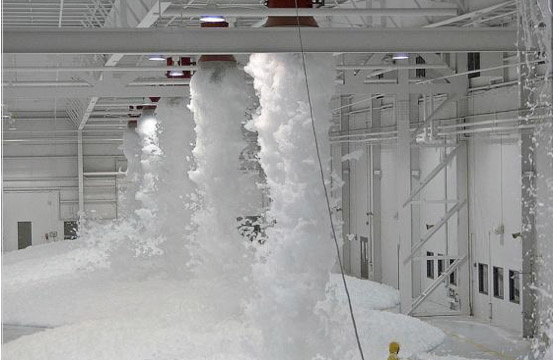Foam extinguishing systems
are a complex extinguishing technique
Extinguishing foam is a mixture of water, foam agent and air
The technology contained in foam extinguishing systems is highly complex and can therefore rarely be summarised in just a few words. As with all other extinguishing technologies, the application or fire load also determines the given solution for foam extinguishing systems. A wide range of guidelines must be taken into consideration for the design and layout of such systems. The corresponding country-specific guidelines can vary significantly.
Extinguishing foam is essentially a mixture of water, foaming agent and air. The mixture ratio of these three substances is adapted depending on the application.
The extinguishing effect comes from the heat-resistant foam forming a solid blanket over the flammable materials. This creates a cooling, separating and suppressive effect depending on the type of foam. The foam isolates the flames from the oxygen supply and suppresses the development of toxic flue gases. The chemical reaction for combustion is therefore halted and the flame is extinguished.
Areas of application:
In general, foam can be used anywhere that water alone would not have the desired extinguishing effect or the use of gas extinguishing systems or water mist systems would not be effective. Its largest area of application is therefore for combustible and highly flammable liquids. Foam is a good solution if there is a particularly high risk of a reignition and the burning material must therefore be separated from oxygen for a long period of time. It is also important to note that if one attempts to extinguish burning oil or fat fires with water, this could lead to an explosion.
Thanks to ACCURO's strong commitment within the area of power plant construction and oil production, a significant number of different models have been introduced onto the market. ACCURO exclusively uses components from renowned manufacturers with the necessary approval.
Areas of use for foam extinguishing systems include for example:
- Chemical industry
- Refineries
- Power plants
- Waste incineration plants
- Logistics halls with a high percentage of plastic
- Aircraft maintenance halls
- Helicopter landing pads
- Offshore platforms and ships
- Tyre warehouses
- Coal silos
- Pipeline pumping stations
- Mineral oil tanks including the collection containers
- Transporting stations for mineral oils and much more

Low-expansion foam:
Expansion ratio: 8 – 20 times
Low-expansion foam is a wet foam with a high weight and a small volume. It is used for fires of liquids or solids belonging to the fire classes A and B. The extinguishing effect of low-expansion foam is largely based on the separating and cooling effect.

Medium-expansion foam:
Expansion ratio: up to 200 times
Medium-expansion foam is a moist to dry foam (depending on the expansion ratio) with a low weight and a large volume. Medium-expansion foam is significantly lighter than low-expansion foam. In addition to the suppressing effect of medium-expansion foam, it also has a separating and secondary cooling extinguishing effect.
High-expansion foam:
Expansion ratio: over 200 times
High-expansion foam has an exceptionally low weight and a large volume. High-expansion foam is also particularly dry. Due to its low weight, it can not be thrown and must be sprayed through special foam generators in the extinguishing area. The extinguishing effect is largely a separating and suppressing effect.

We advise you on the various extinguishing systems
Contact us:




